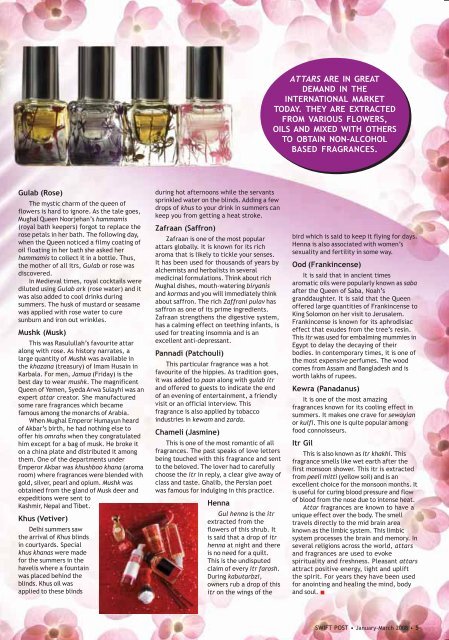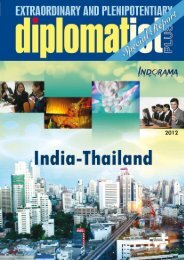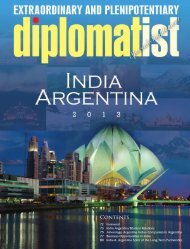SWIFT Post - LB Associates
SWIFT Post - LB Associates
SWIFT Post - LB Associates
Create successful ePaper yourself
Turn your PDF publications into a flip-book with our unique Google optimized e-Paper software.
ATTARS ARE IN GREAT<br />
DEMAND IN THE<br />
INTERNATIONAL MARKET<br />
TODAY. THEY ARE EXTRACTED<br />
FROM VARIOUS FLOWERS,<br />
OILS AND MIXED WITH OTHERS<br />
TO OBTAIN NON-ALCOHOL<br />
BASED FRAGRANCES.<br />
Gulab (Rose)<br />
The mystic charm of the queen of<br />
flowers is hard to ignore. As the tale goes,<br />
Mughal Queen Noorjehan’s hammamis<br />
(royal bath keepers) forgot to replace the<br />
rose petals in her bath. The following day,<br />
when the Queen noticed a filmy coating of<br />
oil floating in her bath she asked her<br />
hammamis to collect it in a bottle. Thus,<br />
the mother of all itrs, Gulab or rose was<br />
discovered.<br />
In Medieval times, royal cocktails were<br />
diluted using Gulab ark (rose water) and it<br />
was also added to cool drinks during<br />
summers. The husk of mustard or seasame<br />
was applied with rose water to cure<br />
sunburn and iron out wrinkles.<br />
Mushk (Musk)<br />
This was Rasulullah’s favourite attar<br />
along with rose. As history narrates, a<br />
large quantity of Mushk was available in<br />
the khazana (treasury) of Imam Husain in<br />
Karbala. For men, Jamua (Friday) is the<br />
best day to wear mushk. The magnificent<br />
Queen of Yemen, Syeda Arwa Sulayhi was an<br />
expert attar creator. She manufactured<br />
some rare fragrances which became<br />
famous among the monarchs of Arabia.<br />
When Mughal Emperor Humayun heard<br />
of Akbar’s birth, he had nothing else to<br />
offer his omrahs when they congratulated<br />
him except for a bag of musk. He broke it<br />
on a china plate and distributed it among<br />
them. One of the departments under<br />
Emperor Akbar was khushboo khana (aroma<br />
room) where fragrances were blended with<br />
gold, silver, pearl and opium. Mushk was<br />
obtained from the gland of Musk deer and<br />
expeditions were sent to<br />
Kashmir, Nepal and Tibet.<br />
Khus (Vetiver)<br />
Delhi summers saw<br />
the arrival of Khus blinds<br />
in courtyards. Special<br />
khus khanas were made<br />
for the summers in the<br />
havelis where a fountain<br />
was placed behind the<br />
blinds. Khus oil was<br />
applied to these blinds<br />
during hot afternoons while the servants<br />
sprinkled water on the blinds. Adding a few<br />
drops of khus to your drink in summers can<br />
keep you from getting a heat stroke.<br />
Zafraan (Saffron)<br />
Zafraan is one of the most popular<br />
attars globally. It is known for its rich<br />
aroma that is likely to tickle your senses.<br />
It has been used for thousands of years by<br />
alchemists and herbalists in several<br />
medicinal formulations. Think about rich<br />
Mughal dishes, mouth-watering biryanis<br />
and kormas and you will immediately think<br />
about saffron. The rich Zaffrani pulav has<br />
saffron as one of its prime ingredients.<br />
Zafraan strengthens the digestive system,<br />
has a calming effect on teething infants, is<br />
used for treating insomnia and is an<br />
excellent anti-depressant.<br />
Pannadi (Patchouli)<br />
This particular fragrance was a hot<br />
favourite of the hippies. As tradition goes,<br />
it was added to paan along with gulab itr<br />
and offered to guests to indicate the end<br />
of an evening of entertainment, a friendly<br />
visit or an official interview. This<br />
fragrance is also applied by tobacco<br />
industries in kewam and zarda.<br />
Chameli (Jasmine)<br />
This is one of the most romantic of all<br />
fragrances. The past speaks of love letters<br />
being touched with this fragrance and sent<br />
to the beloved. The lover had to carefully<br />
choose the itr in reply, a clear give away of<br />
class and taste. Ghalib, the Persian poet<br />
was famous for indulging in this practice.<br />
Henna<br />
Gul henna is the itr<br />
extracted from the<br />
flowers of this shrub. It<br />
is said that a drop of itr<br />
henna at night and there<br />
is no need for a quilt.<br />
This is the undisputed<br />
claim of every itr farosh.<br />
During kabutarbzi,<br />
owners rub a drop of this<br />
itr on the wings of the<br />
bird which is said to keep it flying for days.<br />
Henna is also associated with women’s<br />
sexuality and fertility in some way.<br />
Ood (Frankincense)<br />
It is said that in ancient times<br />
aromatic oils were popularly known as saba<br />
after the Queen of Saba, Noah’s<br />
granddaughter. It is said that the Queen<br />
offered large quantities of Frankincense to<br />
King Solomon on her visit to Jerusalem.<br />
Frankincense is known for its aphrodisiac<br />
effect that exudes from the tree’s resin.<br />
This itr was used for embalming mummies in<br />
Egypt to delay the decaying of their<br />
bodies. In contemporary times, it is one of<br />
the most expensive perfumes. The wood<br />
comes from Assam and Bangladesh and is<br />
worth lakhs of rupees.<br />
Kewra (Panadanus)<br />
It is one of the most amazing<br />
fragrances known for its cooling effect in<br />
summers. It makes one crave for sewayian<br />
or kulfi. This one is quite popular among<br />
food connoisseurs.<br />
Itr Gil<br />
This is also known as Itr khakhi. This<br />
fragrance smells like wet earth after the<br />
first monsoon shower. This itr is extracted<br />
from peeli mitti (yellow soil) and is an<br />
excellent choice for the monsoon months. It<br />
is useful for curing blood pressure and flow<br />
of blood from the nose due to intense heat.<br />
Attar fragrances are known to have a<br />
unique effect over the body. The smell<br />
travels directly to the mid brain area<br />
known as the limbic system. This limbic<br />
system processes the brain and memory. In<br />
several religions across the world, attars<br />
and fragrances are used to evoke<br />
spirituality and freshness. Pleasant attars<br />
attract positive energy, light and uplift<br />
the spirit. For years they have been used<br />
for anointing and healing the mind, body<br />
and soul.<br />
<strong>SWIFT</strong> POST • January-March 2008 • 5






